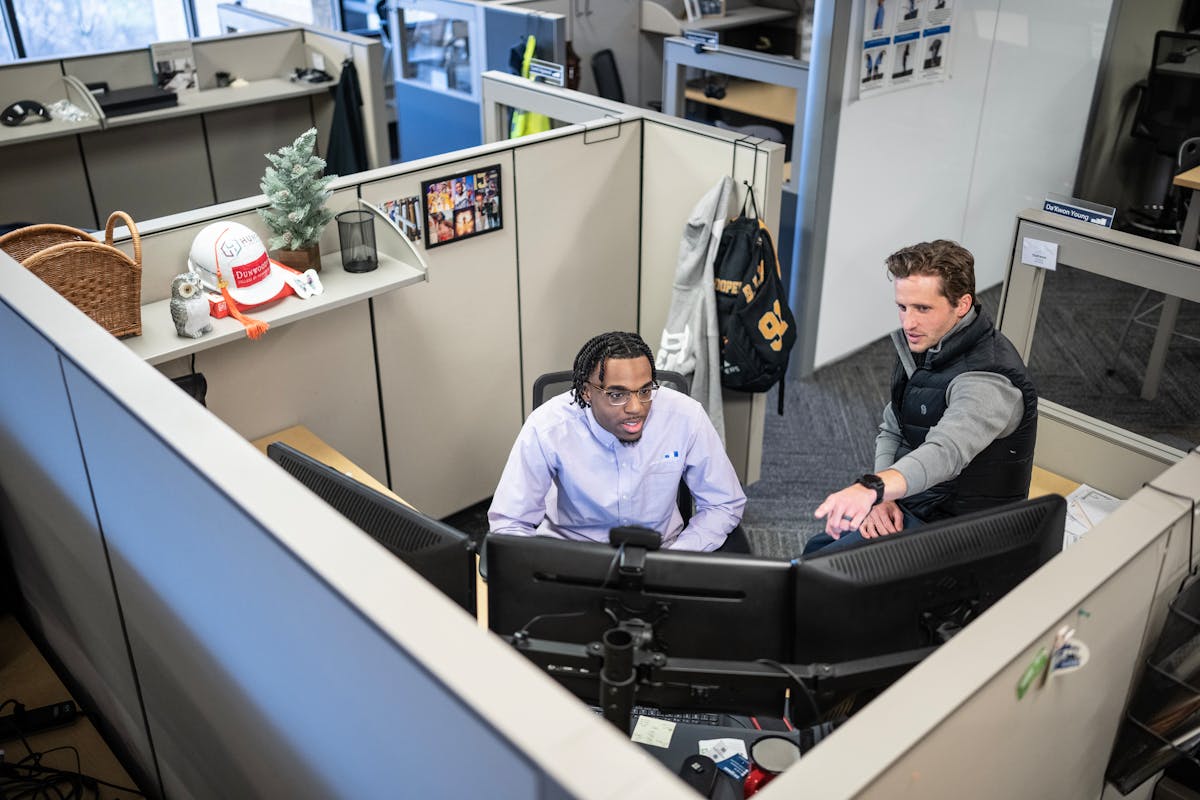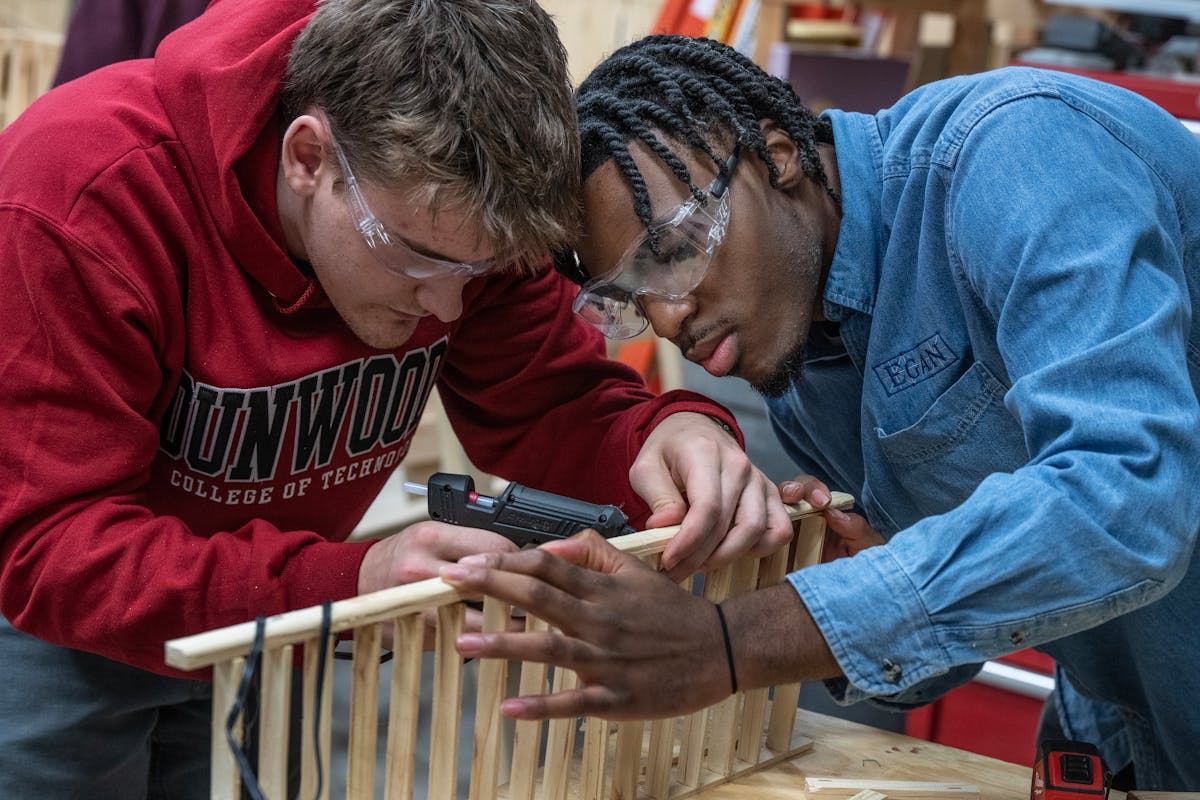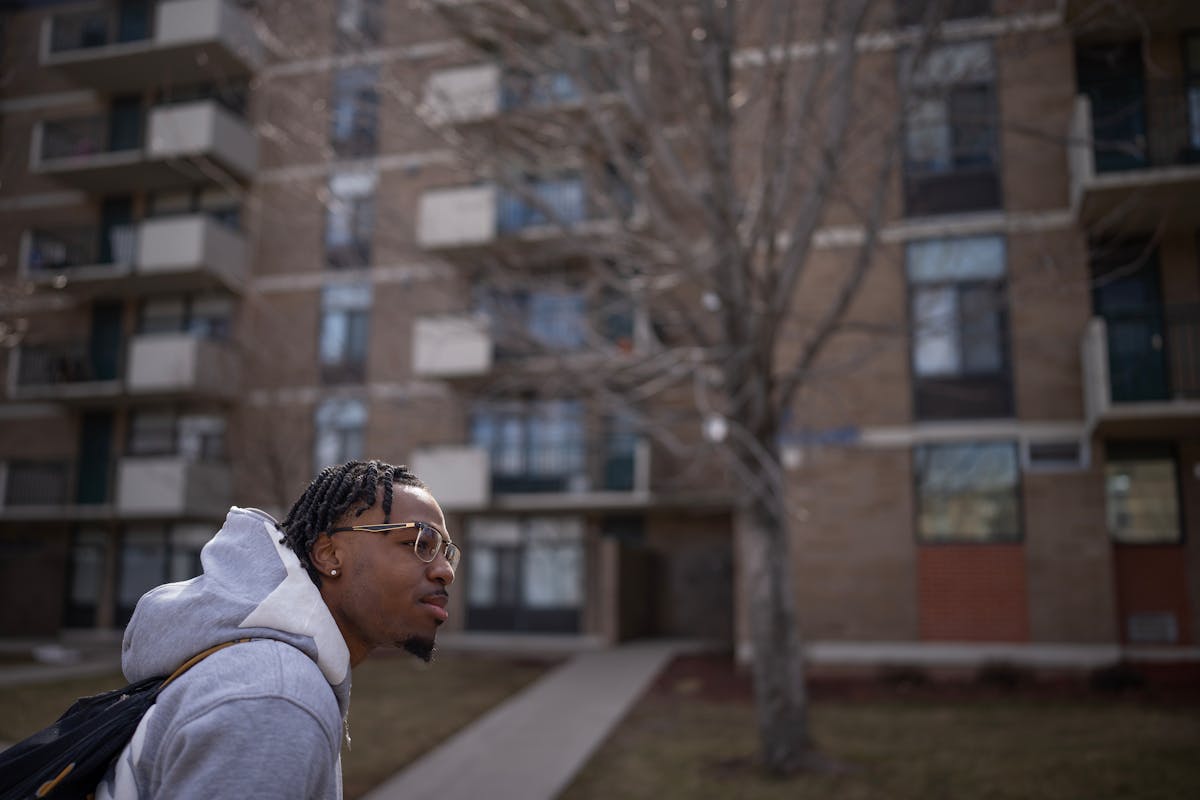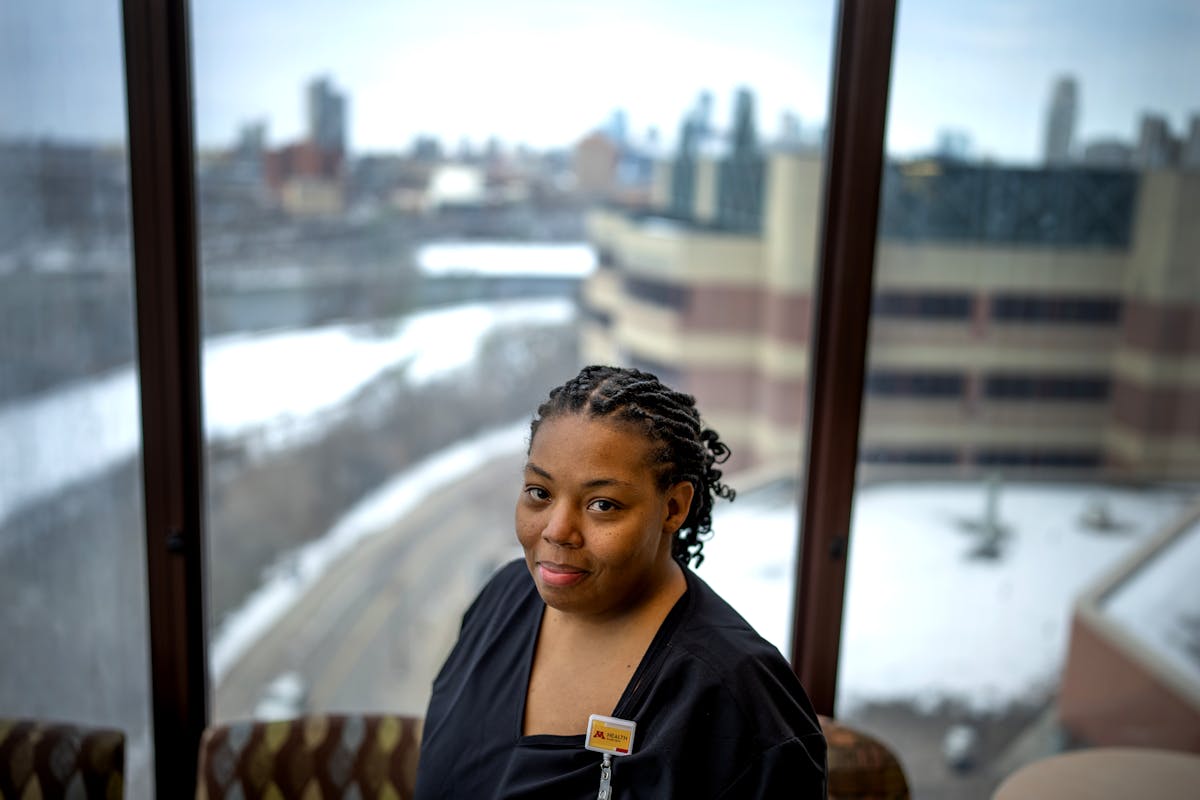Black Minnesotans have made income gains, but wide disparities persist
At age 17, Da'Kwon Young was in high school, working two jobs and had spent a year sleeping on his grandmother's floor.
Two years later, life is measurably better.
Young is now a Mortenson Construction scholarship winner and project-management intern, on track to make around $80,000 a year after he completes his education at Dunwoody College of Technology and joins Mortenson full time next year.
"It's crazy how I went from being homeless and no plan for my future, to now I've got work, a place to live and I'm in college," said Young, who studies blueprints, tracks down subcontractors and visits build sites to access the tools and materials needed.
Young, who is Black, is joining a select class. According to new data the Federal Reserve Bank of Minneapolis compiled, only 25% of Black Minnesotans made $44,000 a year or more before the pandemic. Half were making less than $26,000, about $15,000 less than the median wage of white Minnesotans.
Black Minnesotans have made economic gains in recent years, such as Black income realizing the fastest growth of any race or ethnicity between 2014 and 2019 when it increased 32% above the rate of inflation. Black unemployment also dropped a little more than half in that same span, down to 4.9%.
But those gains have done little to close the wide disparities that have long existed in Minnesota. When looking at a longer time frame, 2005 to 2019, Black income didn't grow as fast as other groups. It's also clear the 2008 Great Recession hit Black Minnesotans the hardest, and it took them the longest to recover. Such income disproportion concerns Black leaders, state officials and economists who noted half of Black wage earners in the state still don't make enough to live comfortably.
"Blacks are earning 60 percent of what white earners are earning at the median," said Abigail Wozniak at the Minneapolis Fed. "This is something that Black earners in particular in the United States have been experiencing pretty much since around 2005."
History of inequity
Wozniak added African Americans were also one of the groups the COVID-19 pandemic hit the hardest, though the Fed's Income Distributions and Dynamics in America report, compiled using W-2 and U.S. Census Bureau information, doesn't yet include those years of data.
Reasons for wage inequities trace back to generational poverty and the long tentacles of Jim Crow laws that stifled Black access to quality jobs, schools and housing. State employment professionals, such as Minnesota Department Employment and Economic Development (DEED) Deputy Commissioner Marc Majors, said a lack of access to transportation, affordable child care, education and professional networks have also hindered income growth for African Americans.
"Obviously, educational attainment is a big one," Majors said.
With it, the climb toward middle-class salaries transitions from a slow and gritty slog to more of a sprint.
"Skills gaps are the largest remaining reason for differences in income" among the races, said author and Harvard University economist Ron Ferguson, who serves as the faculty director of the Achievement Gap Initiative. "Other things still matter. There's still racism. There is still discrimination. There are still all these other things. But if we could close the skills gap, we could go a substantial distance towards narrowing income gaps."
In the wake of George Floyd's murder in 2020, companies like 3M, U.S. Bank, Mortenson, Target and scores of other private Minnesota employers pledged to hire more Black and brown workers and to analyze internal wage and promotion data for inequities. Best Buy, Aon, Mortenson Construction and UnitedHealth created scholarships, apprenticeships or internships aimed at Black workers in the hopes of narrowing wage disparities.
The state invested more than $90 million in job training grants so Black Minnesotans — as well as other people of color, military veterans, young, low income and other underserved workers — can access apprenticeships and training as well as earn professional accreditations needed to move into higher-paying, higher-skill careers. State officials are promoting the initiatives to eligible individuals, community groups and businesses around the state.
One state program steers participants into "high-demand" fields such as education, technology, construction, health care and energy.
"The median income level for Black Minnesotans is still significantly lower than white Minnesotans and even some of the other nonwhite populations," Majors said. "So we have to find ways to get folks over [and into] a family-sustainable wage and income."
Black median income pre-pandemic was slightly less than that of Latinos and only marginally more than Native Americans.



Exhausting resources
Tapping skills training and other career resources means "no excuses" to Elara Smith, a 34-year-old Black Robbinsdale resident who has always worked two or three jobs to survive. She's also used job training, skill-certification programs and job changes to boost her income.
"My advice to people now is to be patient, use all the resources that they have and don't give up," Smith said.
Fresh out of high school, Smith worked round-the-clock jobs at White Castle and as an in-home personal-care aide (PCA) while catching 5 a.m. buses, dealing with an unexpected pregnancy and enduring one stint of homelessness.
"Once I found out I was pregnant, I said, 'That $7.25 is not going to make it,'" Smith said of switching to the night shift at White Castle so her pay would rise to $10 an hour.
Smith also obtained her PCA certificate by taking a free online Hennepin County course and then started shifts caring for elders. Eventually, she took First Student's commercial driving training program, earned her license and started driving school buses in Brooklyn Park for $13 an hour. She saved on day-care costs by bringing her baby daughter on her bus routes. Her mother, who has since passed away, cared for her baby on other days.
Within a few years, Smith was driving buses on weekends for Metro Transit, weekdays for Minneapolis Public Schools and shoe-horning jobs in between as a PCA for elderly patients at home. There wasn't much sleep. But her wages grew from $16 to $25 an hour.
Now with a husband and two children, she wants more stability. More income. More skills. She found a nursing-apprentice program on the recruiting website Indeed and applied. By October, she had enrolled in a certified nursing assistant training program through Hired, a Minneapolis-based job-training organization. In March, she was hired by M Health Fairview University of Minnesota Medical Center.
She makes $28 an hour, about $58,200 a year. As she put on scrubs for her first day at her new job, Smith beamed.
"Today, I am very excited for this opportunity. My life will change," she said. "I was poor. Now I would say I am more than just surviving. I have moved from poor to being OK and not being so stressed about paying my [bills]. This has helped me a lot."
Hired's Job Placement Specialist Serena Armstrong said trainees successfully transition into well-paying careers when they have real support that eliminates barriers to work.
"This is one of those village efforts and is more than about just providing job training," Armstrong said.
Forty of her 53 nursing students are Black and most are mothers. Some are homeless and living with relatives. Most have jobs, but none pay well. Most trainees come to Hired from customer service or in-home aide jobs making $15 to $17 an hour.
When Smith first applied to her program, Armstrong helped Smith obtain grants to fix a broken car and tackle a stressful heating bill. The small grants — from much-needed donors as well as state and federal government — let trainees focus on their nursing skills and securing the best hospital jobs, Armstrong said. Hired fills in gaps with $20 gift cards for transportation, cellphones and Wi-Fi costs so trainees can stick with the program, go to job interviews and/or have the technology needed to reach hospital and clinic recruiters.
"My job is to break down as many of those barriers or walls as I am allowed to so these students have a clear path to success, one that does not get held back by any of these systemic societal problems," Armstrong said. "We've been able to get some of my students placed into nursing roles that pay almost double what they were making."

Hustling for more
To reach income levels white Minnesotans have, some Black workers shift into overdrive, juggling several jobs at once or going into business for themselves.
Therapist Anissa Keyes opened her own clinic, Arubah Emotional Health Services, in Minneapolis after discovering her first clinic employer paid her 24% less than her white co-worker. The difference existed despite both obtaining their master's degrees, starting at the clinic at the same time and working similar caseloads. Keyes, the only Black therapist at the clinic, went from making $21 an hour at the clinic to $80 an hour as a business owner.
Maple Grove real estate title expert Brenda Colston has worked six and sometimes seven jobs to ensure her income grew from $30,000 to as much as $140,000 some years. She piled on part-time jobs: title mortgage closer, escrow manager, office administrator, event planner and, periodically, even Uber driver.
In time, the wife and mother of four now-grown children focused on one career — title work — and eventually went into business for herself. To make a good income, "you have to have good connections and mentors," Colston said.
"I definitely know I would not have known what to do if I didn't have somebody holding my hand and teaching me," she said.
Young, the Mortenson intern, credits his mother and mentors for his path up the income ladder. It's been a long journey, said Young's mother, Ashley, who is proud of how far she and her son have come. He makes $19.50 an hour as an intern with Mortenson and has the possibility of making $37 an hour when he graduates next year.
When Ashley Young became pregnant at age 16, she made a pact with her unborn son that she'd always "have his back" and provide for him. Her own mother, welfare and preschool helped during her son's first three years. A series of temp agency babysitting, food service and in-home elder-care jobs followed. But she wanted more.
She earned her GED, enrolled in nurse job training programs and watched her pay scoot from $15 to $22.75 an hour as she gained skills that led her to become a patient assistant coordinator and then a patient safety monitor at Abbott Northwestern Hospital in Minneapolis. In late April, she began a medical assistant apprenticeship at Allina Health that means taking college courses while also working in clinics. She'll soon learn to give injections, wrap wounds, take vital signs and prepare patients for doctor visits.
"As Da'Kwon progressed in school, I said that this is the time for me to progress and go back to school," Ashley Young said, adding she isn't sure who is following whom as she and her son simultaneously delve into apprenticeships that guarantee higher wages.
Early on, construction was never in Da'Kwon Young's vision because he and his mom didn't know much about those careers. But today, the profession and its training have created a roadmap to a better life.
"That was always the idea, to go further in life than [my mom] or my dad," he said. "Now that I am working, I am really happy and want to see how far I can take this."
